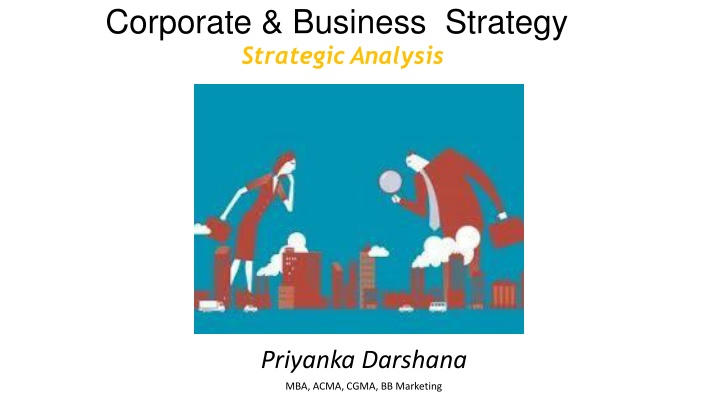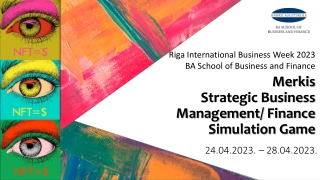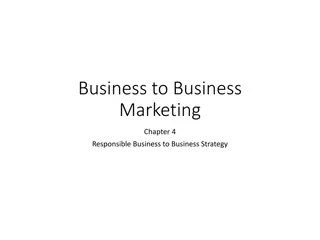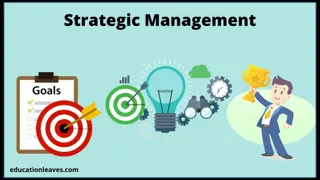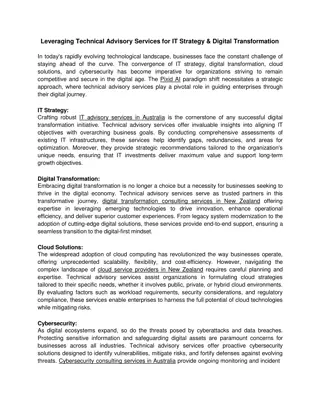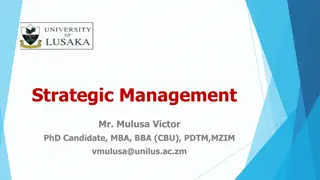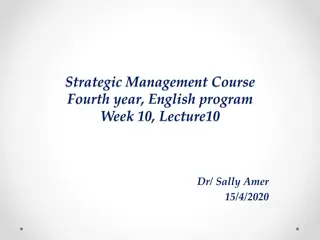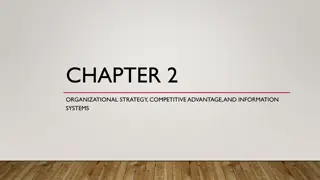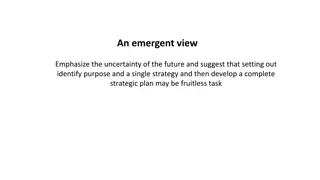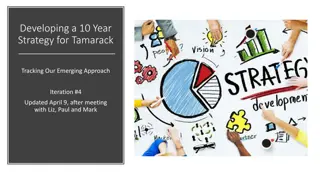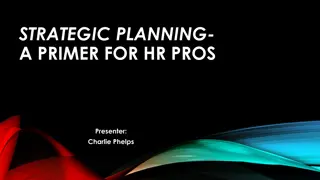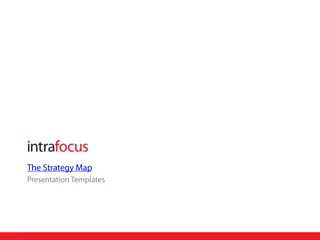Strategic Analysis and Business Strategy Overview
This presentation delves into corporate and business strategy, including strategic analysis, external appraisal, micro, and macro environment analysis. It explores where companies compete, strategic group mapping, market analysis, competitor perception, industry forces, and PESTEL/MACRO analysis, providing insights into factors influencing business decisions.
Download Presentation

Please find below an Image/Link to download the presentation.
The content on the website is provided AS IS for your information and personal use only. It may not be sold, licensed, or shared on other websites without obtaining consent from the author.If you encounter any issues during the download, it is possible that the publisher has removed the file from their server.
You are allowed to download the files provided on this website for personal or commercial use, subject to the condition that they are used lawfully. All files are the property of their respective owners.
The content on the website is provided AS IS for your information and personal use only. It may not be sold, licensed, or shared on other websites without obtaining consent from the author.
E N D
Presentation Transcript
Corporate & Business Strategy Strategic Analysis Priyanka Darshana MBA, ACMA, CGMA, BB Marketing
What do we analysis MICRO Environment MACRO Environment
Where do we compete ? MICRO
Strategic Group Mapping A management that groups companies within an industry that have similar business models or similar combinations of strategies strategic group is a concept used in strategic DI High D2 Low High
Burger Market analysis
Rivalry Element Level Favorable / Unfavorable U U U F F F Number of competitors Size Growth rate Differentiation Exit barriers Industry against Revelry High Big & medium Slow High Low
Five Industry Forces Force Status Favorable / Unfavorable U U U F U U Revelry Intensive High High Low Many Threat of New Entry Buyer's Power Supplier s Power Substitutes Overall Industry Attractiveness
PESTEL / MACRO Analysis Organization
Political Factors How government policy and actions intervene in the economy and other factors that can affect a business. These include the following: Tax Policy Trade Restrictions Tariffs Bureaucracy Different political parties in a country have diverging views and strategies for policy on the items above.
Economic Factors Economic Factors take into account the various aspects of the economy, and how the outlook on each area could impact your business. These economic indicators are usually measured and reported by Central Banks and other GovernmentAgencies. Economic Growth Rates Interest Rates Exchange Rates Inflation Unemployment Rates The Economic outlook is of extreme importance for a business.
Social Factors Which are related to the cultural and demographic trends of society. Social norms and pressures are key to determining a society consumerist behavior. Factors to be considered are the following: Cultural Aspects & Perceptions Health Consciousness Populations Growth Rates Age Distribution CareerAttitudes
Technological Factors Technological Factors are linked to innovation in the industry, as well as innovation of the overall economy. Not being up to date to the latest trends of a particular industry can be extremely harmful to operations. Technological Factors include the following: R&D Activity Automation Technological Incentives The Rate of change in technology
Environmental Factors Ecological impacts on business. As weather extremes become more common, businesses need to plan how to adapt to these changes. Key Environmental Factors include the following: Weather Conditions Temperature Climate Change Pollution Natural disasters (tsunami, tornadoes, corona etc.) Additionally, there is increasing importance for businesses to be environmentally friendly with their operations, as evidenced by the rise Corporate Sustainability Responsibility (CSR) initiatives. Examples of CSR initiatives include carbon footprint reduction efforts and transitions into renewable material and energy sources.
Legal Factors There is often uncertainty regarding the difference between Political and Legal Factors in the context of a PESTEL analysis. Legal Factors pertain to any legal forces that define what a business can or cannot do. Political Factors involve the relationship between business and the government. Political and Legal Factors can intercept when governmental introduce legislature and policies that affect how businesses operate. Legal factors include the following: bodies Industry Regulation Licenses & Permits Labor Laws Intellectual Property Consumerism
Opportunities and threats Combined, these six factors have a profound impact on the opportunities and threats for a business going forward
Scenarios Scenarios are detailed and plausible views of how the environment of an organisation might develop in the future based on key drivers of change about which there is a high level of uncertainty. Build on PESTEL analysis . Do not offer a single forecast of how the will change. An organisation should develop a few alternative scenarios (2 4) to analyse future strategic options. environment
Carrying out scenario analysis Identify the most relevant scope of the study the relevant product/market and time span. Identify key drivers of change PESTEL factors that have the most impact in the future but have uncertain outcomes.Develop scenario stories - That is, coherent and plausible descriptions of the environment that result from opposing outcomes Identify the impact of each scenario on the organisation and evaluate future strategies in the light of the anticipated scenarios.
Strategic Analysis Internal Appraisal External Appraisal Organisational capability profile (OCP) Environmental threat and opportunities profile (ETOP) Resources Where to Compete Capabilities Industry position Competitive advantages PEST/PESTEEL factors Strengths/weaknesses Opportunities/threats SWOT Analysis
